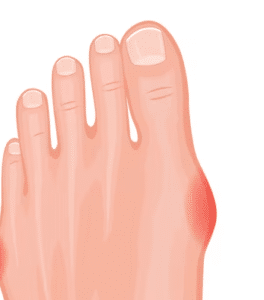All About Bunions

Hallux valgus, otherwise known as bunions, are the most common foot problem in the United States. Studies show that bunions become more common with age and in females, but just about anyone can be affected by bunions. Today, we’re going to take a look at what bunions are, how they are formed, risk factors for patients with bunions, conservative (non-surgical treatment) for bunions and surgical treatment for bunions.
What are bunions?
Bunions are the forming of a lump on the outer edge of your foot. In scientific terms, it is a bursa sac that develops over the first metatarsophalangeal (MTP) joint as a result of a hallux valgus deformity. This bump is on the outer edge of your big toe, and usually causes a lot of pain due to the change in the shape of your foot. This usually causes the big toe to go inward, either layering itself over or under its neighboring toe. Bunions can lead to an abundance of pain, other conditions, and internal changes. Bunions can also have a long list of causes and can be hereditary or caused by something external.
How are bunions formed?
Most of the time, bunions are caused by genetics and a person’s poor or faulty foot structure which is inherited. This is not the patient’s fault but needs to be addressed for optimal foot health. Bunions can also be caused by foot stress and injuries or by a deformity present at birth. They also might appear in conjunction with specific types of arthritis that affect the feet. There is a debate on whether the wearing of poor-fitting shoes can cause bunions or if they rather just add to an already existing issue – further developing a bunion on the toe. Bunions, once formed, can be made worse by footwear that doesn’t fit or has a heel, by constant walking or being on the feet, or foot arthritis.
Risk factors for patients with bunions
Bunions cause many different symptoms, some lesser while others are severe. Here are some of the most common symptoms related to bunions:
- Inflamed or red skin at the affected area
- Calluses or thick skin at the bottom of the toe
- The toe changing positions or directions, pushing toward surrounding toes
- Calluses on the second toe due to being overlapped
- Persistent or randomized pain
- Issues with moving the big toe
- And more
Not only can these symptoms persist, but an untreated bunion can also cause other foot, ankle, hip, and knee problems over time. Some of those issues might be:
- Hammertoe
- Flat feet
- Corns and calluses
- Ingrown toenails
- Ankle pain
- Heel pain
- Knee pain
- Hip pain
- Fatigue
- Difficulty walking
- Lower back pain
- Bursitis
- And more
Conservative treatment options
When we say conservative treatment, we mean treatment options that do not include surgery. Nonsurgical options for bunions usually start with a discussion about the types of footwear the patient wears. Often, the doctor will first suggest modifying their footwear by adding in padded soles or arch supports. Another option a doctor may suggest is taping your foot so it can heal and revert back to its original state. If the type of shoes you commonly wear is an issue, your doctor will suggest a switch in type or potentially in size. Your shoes should not fit too snug, and you should have a fair amount of wiggle room. If pain is persistent, over-the-counter pain relievers may be suggested to help with that. If these options aren’t helping, that’s when a surgical approach may be necessary.
Surgical treatment options
When conservative treatment options aren’t working, that is when your doctor might suggest a surgical treatment option. Surgical treatment options are often suggested if there is severe pain when the patient is walking and going about their daily life. Surgery is done on the foot to reduce the pain related to the bunion and to correct the deformity. The types of surgery depend on the severity and placement of the bunion on the toe or foot. This might be for a mild bunion, moderate bunion, severe bunion, arthritic bunion, or big toe joint bunion. Most of these surgeries include the removal of the enlarged part of the bone, along with the adjustment or shifting of the bone, surrounding muscle, tendons, and ligaments. Occasionally, surgery may include joint replacement or reconstruction.
Much like any other surgery, there are some complications that might arise after the procedure. Here are some of the most common ones:
- Numbness
- Swelling
- Delayed or slow healing
- Stiffness
- Infection
- Recurrence of the bunion
- Continued pain
- Nerve damage
- Overcorrections that lead to the big toe straying too far away from the other toes
- Depending on your medical history, other symptoms may arise.
After surgery, the recovery process may be different for some depending on the initial severity and placement of the bunion and the patient’s medical history. Your doctor may advise you to limit your activity, elevate the affected foot while lying down to help reduce swelling and pain, apply ice to the area, or even use a cane or walker while you heal. You’ll also probably need to refrain from getting the area wet until your stitches are removed, which is usually scheduled for two weeks after the initial surgery appointment. When taking pain medicine, always discuss with your doctor to find the appropriate options because some aspirins can make the issue much worse. Antibiotics may also be an option for you, if necessary and deemed appropriate by your doctor.
For months after surgery, your doctor will advise you on the types of shoes that you should wear and which you need to avoid (such as high heels). They will also help you work on a safe exercise program, and let you know if you should start physical therapy.
